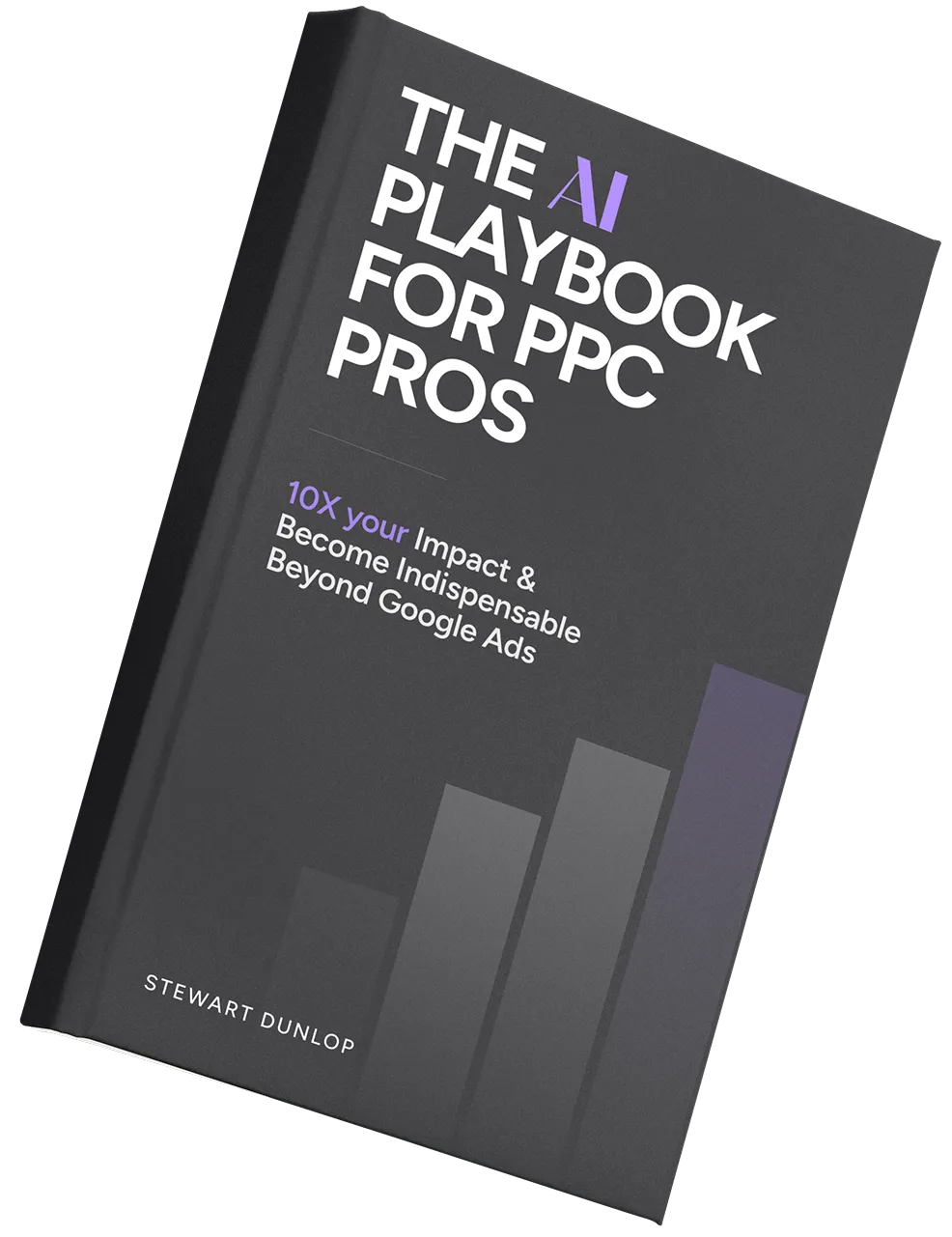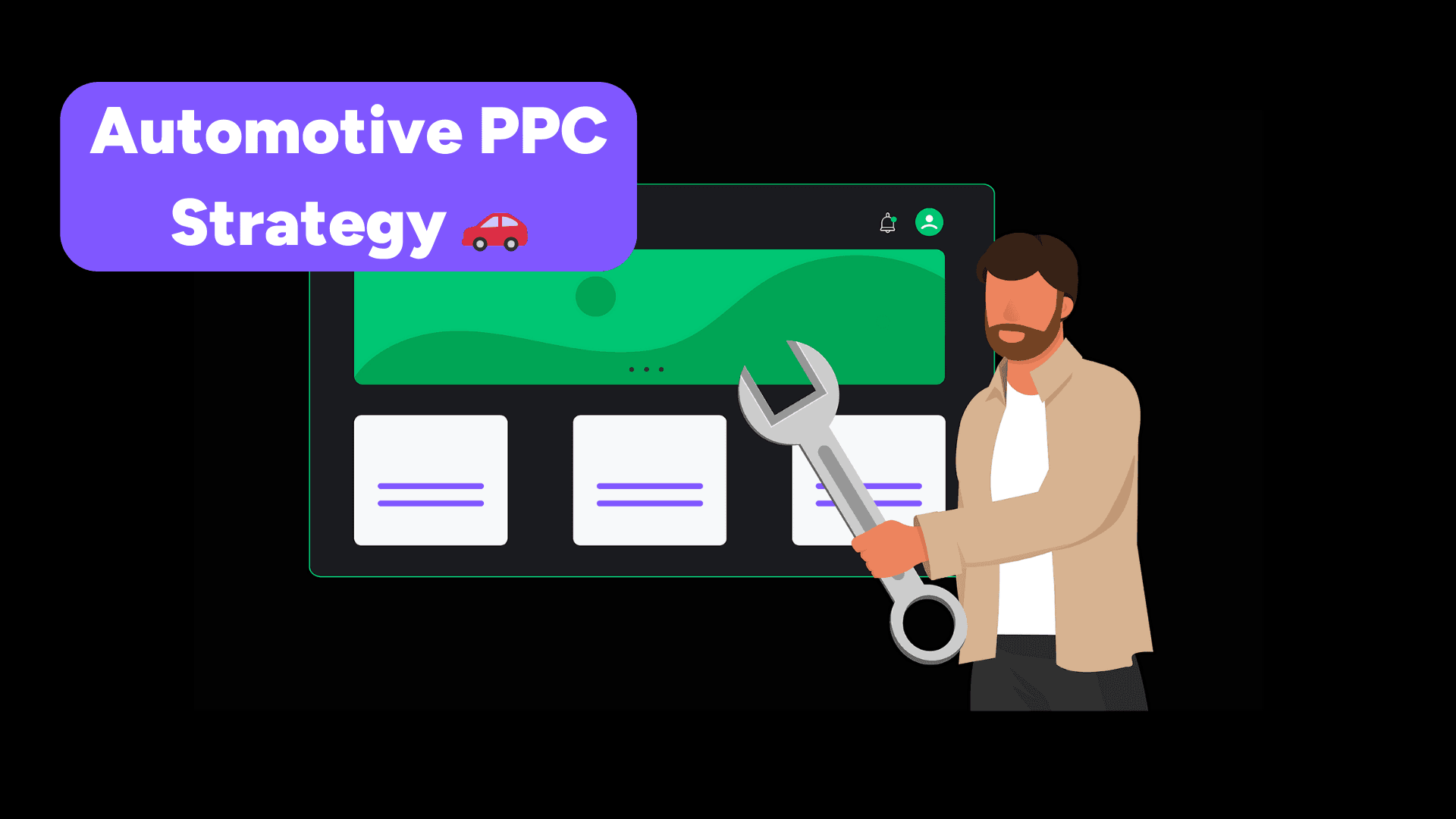
Summary
- Being visible on search engines is crucial for automotive businesses since 95% of their customers start their journey online.
- Pay-per-click (PPC) advertising is an effective digital marketing technique for automotive businesses to get more leads.
- PPC allows you to promote products and services, increase visibility, target specific demographics, and grow your brand.
- The other key benefits of PPC for automotive businesses include highly specific local targeting, a range of different campaign types, trackable results, and retargeting.
- Learn how to start an automotive PPC campaign, set goals, optimize landing pages, create a Google Ads account, target your audience, choose keywords, use ad extensions like 'Call Us,' craft compelling ad copy, place bids, and track your campaign.
Online marketing has become a vital tool for the automotive sector, as it allows car dealers to better connect with customers.
95% of vehicle buyers do their research online. 97% begin their search to purchase, repair, or customize a car on the Internet.
For automotive businesses in 2024, having a strong online presence—especially on search engines like Google—is crucial.
Pay-per-click (PPC) advertising is an effective way to achieve this.
In PPC advertising, your ad appears in the sponsored results section at the top of search results pages. But you only pay when someone clicks on your ad.
Because of this, PPC advertising is budget-friendly and offers a significant return on investment (ROI).
📈 ROI example
For example, attracting a potential car buyer using a PPC campaign typically costs about $250. This figure is based on the average click cost of $2.50 and the roughly 100 website visits needed to make a sale.
Consider the financial impact: selling a car for $48,000 with a 3.9% profit margin nets you approximately $1,872.
So, with an ad spend of $250 leading to a sale, your ROI is a remarkable 648.8%.
Results can vary, but the potential of PPC ads to deliver substantial ROI, attract quality leads, and boost sales conversions is undeniable.
This article will explain the benefits of automotive PPC advertising and how you can set up a strong automotive PPC strategy right from the beginning.
What Is Automotive PPC?
As already mentioned, most people begin looking for automotive services using search engines like Google.
When you Google something, you'll often see ads at the top of a search engine results page. That's PPC advertising.
For instance, if you search for “Toyota Camry,” you'll see various results.
This includes shopping ads and search ads from car dealerships offering this vehicle, along with informational content about this specific car model:
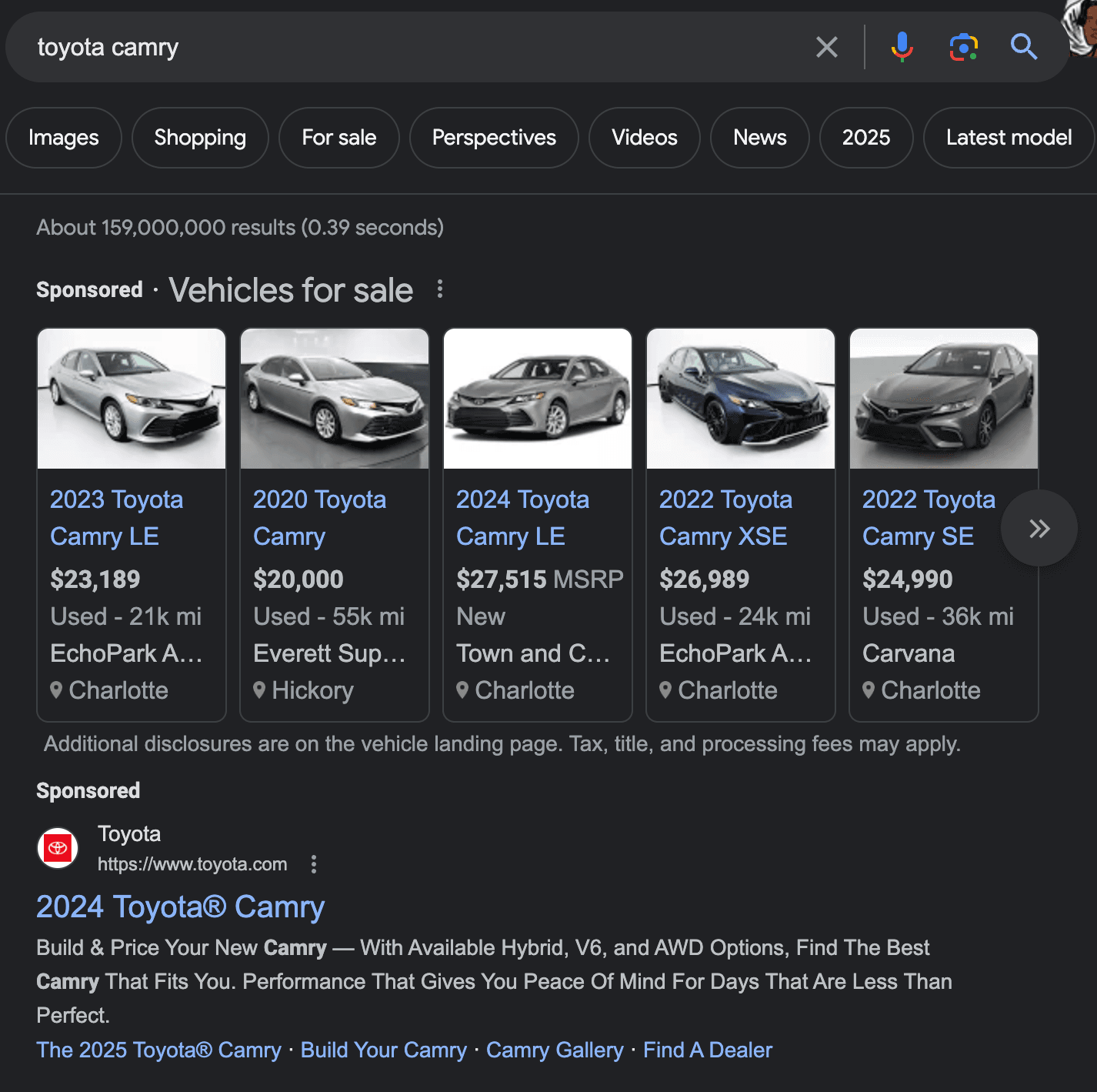
Google is often the go-to destination for car enthusiasts and potential buyers. It's therefore crucial for your business to dominate the top spots on those search engine results pages (SERPs).
Research shows that 75% of users don't venture beyond the first page of search results. So, securing a prime position on that first page isn't just beneficial—it's essential!
You can use this sort of advertising to:
👉 Promote individual auto products and services
👉 Increase your dealership's visibility in search engine results
👉 Precisely target your ads to specific demographics
👉 Grow your brand
Other benefits of PPC ads include:
⏩ Fast, reliable results
🖱️ Guaranteed clicks
✔️ Drive traffic to your website
🔎 Specifically target your ideal customers
💸 Control your spending to suit your budget
🎯 Target customers who have interacted with your website but didn’t take any action
📊 Track your progress
How Does Automotive PPC Advertising Work?
To understand automotive PPC advertising, you need to start with keywords.
Keywords are the terms and phrases people put into the search bar during their online searches.
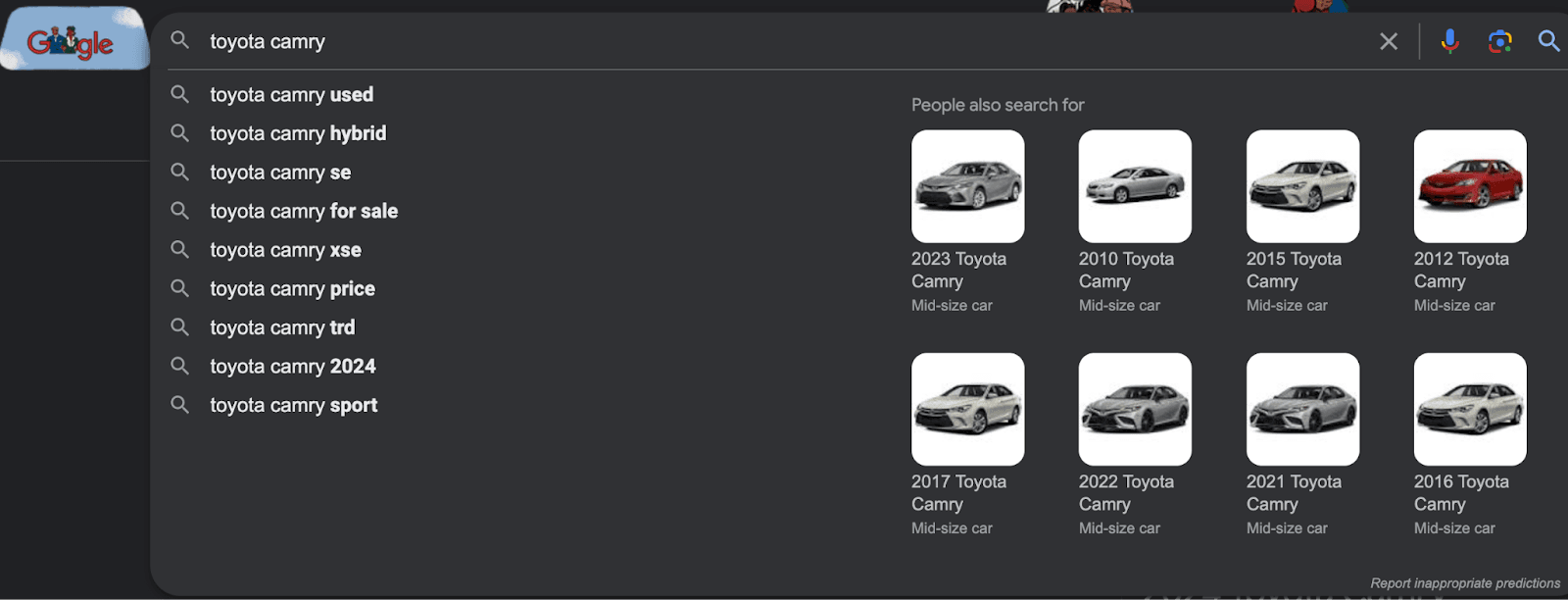
Search engines then use these keywords to figure out what the user wants to see. They help the search engine decide which websites and sponsored car ads to show.
For example, common automotive-related searches might include:
🔎 "Toyota Camry"
🔎 "Affordable cars near me"
🔎 "Car maintenance services"
🔎 "Best family cars 2024"
🔎 "Car loan options"
🔎 “Affordable SUVs in Los Angeles”
Bid for keywords
With PPC, automotive businesses (like car dealers, for instance) set a budget for their ads and decide how much they're willing to pay for each click.
When someone searches for something related to cars, like "affordable SUVs in Miami," an auction starts behind the scenes to determine which ads get displayed.
This auction takes into account:
- Your bid amount.
- How closely the ad matches the search term.
- The quality of the ad itself.
- The relevance and quality of the automotive website linked in the ad.
The ads that score the highest based on these criteria appear at the top of search results.
Ads with lower scores may not appear at all. Remember, each time someone clicks on one of these ads, the automotive business pays from its PPC budget.
This system allows automotive businesses to compete effectively in the auction even if they don't have the highest bid.
They can still win by having relevant and high-quality ads and landing pages.
What determines the price of a bid?
In automotive PPC campaigns, the cost per click is determined by the specific keywords you select.
Keywords that suggest a high intent to purchase—indicating that someone is ready to buy a car or use automotive services—are often in demand and will cost more.
For example, for a car dealership, a keyword like “buy Chevrolet Silverado” has a cost-per-click (CPC) of $30.00.

💡 Note: These figures were sourced from the SEO tool Ahrefs. The actual numbers might differ slightly on various advertising platforms.
These keywords are more expensive because they signal an immediate buying interest, making many automotive dealers and service providers more willing to bid higher for their ads to appear for these searches.
Generally, this type of keyword also has a high search volume, with significant monthly searches globally.
That being said, for high-value items like cars, a keyword phrase such as "buy Chevrolet Silverado" might not be searched often, but it has a strong potential to lead to sales.
The reason for this high CPC is that these keywords are used by people who are already interested in buying specifically this model.
As a result, these keywords are more expensive due to the number of businesses bidding on them. As you can see above, it costs $30.00 per click.
“2023 Chevrolet Silverado 1500” on the other hand, has a CPC of just $1.70 and gets 30K global searches a month.

This keyword is less expensive because people searching might be looking for information about different car models and their costs or features.
While related ads would not be as expensive, these ads may face less competition from other advertisers because there is lower buyer intent.
Different Types of Automotive PPC Campaigns
There are several approaches you can take in your PPC campaigns. Here are a few examples:
Branded campaigns
These campaigns focus on keywords that include your dealership's name or specific brand names you sell.
They capture traffic from users already familiar with your brand or those looking for dealerships that sell a particular brand of car.
Here is an example of a branded ad that comes up when you search “Ford dealership Charlotte NC”:
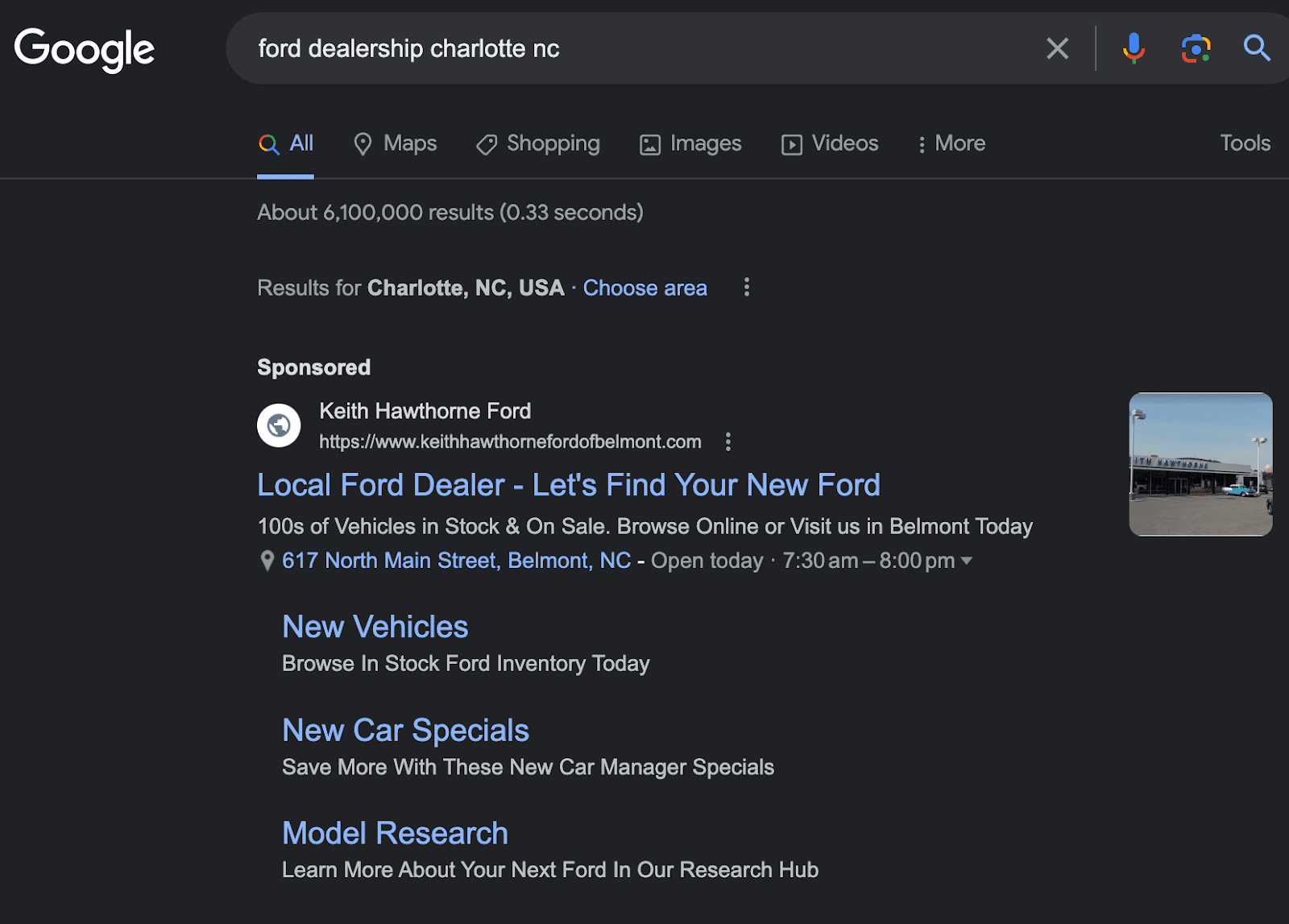
Conquest campaigns
Conquest PPC campaigns are a way for car dealerships to reach people who are interested in a specific car brand.
The idea is to get these customers to think about other car brands instead.
For example, if you sell a range of used car brands, you might use this type of campaign to show your ads to people who have been looking at Toyota cars.
However, there are challenges to this approach, including potentially higher cost-per-click rates and maintaining a decent Quality Score on platforms like Google Ads.
This is because the targeted keywords may not directly align with your website’s content.
It's important to remember that you will need to navigate legal boundaries carefully by avoiding the direct use of competitors' trademarks or branded terms in your ads.
If done right, this strategy can help you stand out against other car dealers and attract customers who might not have considered your brand before.
Here’s an example of a conquest campaign by HendrickCars.
The search was for a Honda dealership. Hendrick Cars does sell this brand, but it also sells many others. It has chosen to focus on other benefits in its ad—a huge inventory, financing, and cars under $20K.
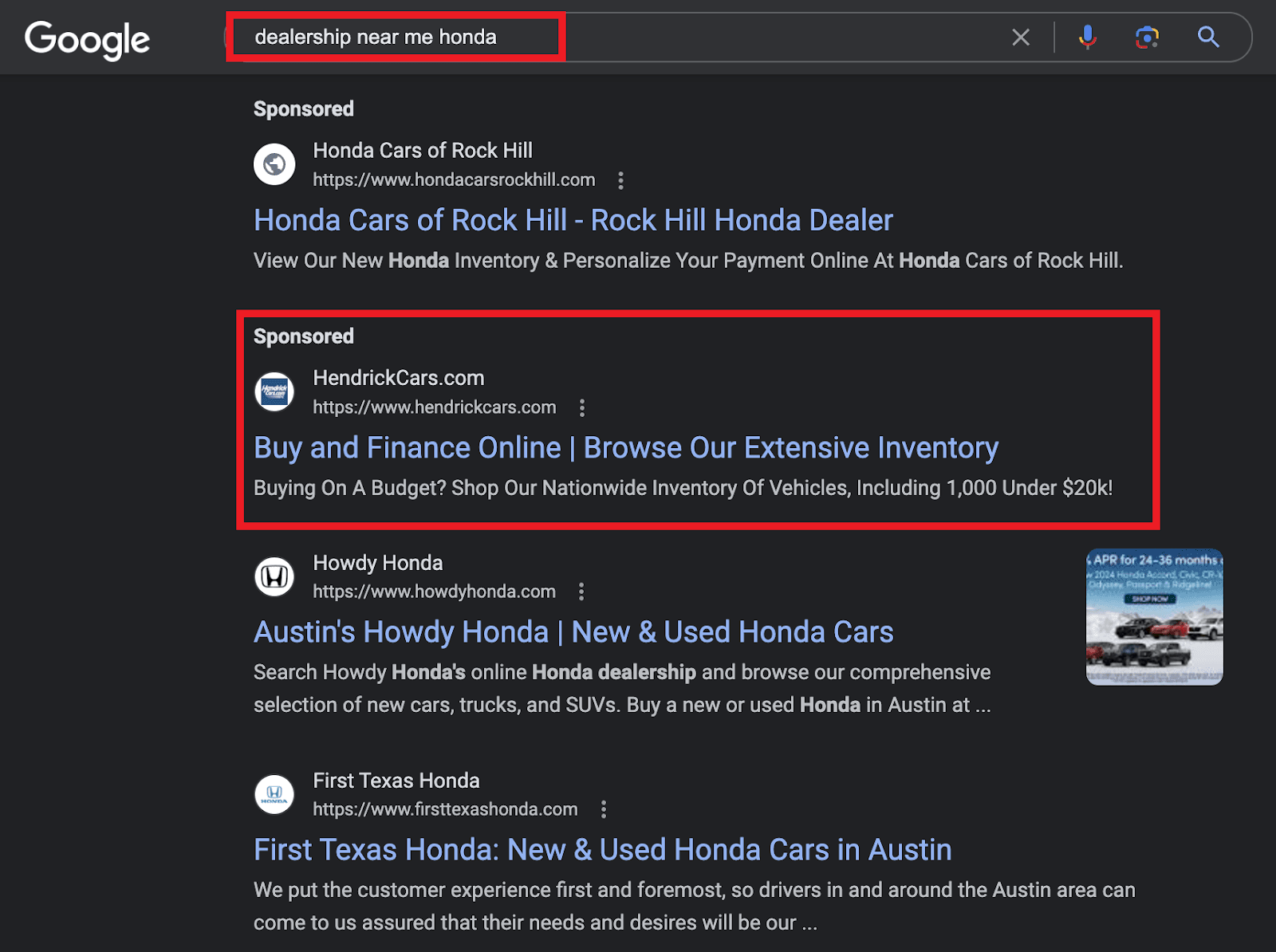
Competitor campaigns
This is similar to a conquest campaign. In these campaigns, you bid on keywords that are related to your competitors.
This allows you to attract customers looking for other dealerships or brands and offer them an alternative option—your automotive business.
In our experience, successful competitor ads need to emphasize customer benefits. This helps draw their attention from the competitor brand they were searching for in the first place.
These advantages could be something unique to your business like:
- Deal assistance
- Home delivery
- Pick up of your current car
Dynamic campaigns
Dynamic search ads customize their content for each viewer. They change images, text, or offers based on someone’s interests, online behavior, or search history.
It’s like having a single ad that adapts to fit different people.
Dynamic campaigns pull information from your dealership’s website to create relevant promotions based on what users are searching for.
For example, if you have a variety of Ford trucks, the system will automatically show specific promotions for these trucks when someone looks up “new Ford trucks for sale.”
This method efficiently ensures your promotions are always aligned with your current inventory.
As your vehicle range changes, so do the promotions, saving you the effort of constantly updating individual campaigns for each vehicle or service.
Local campaigns
Local ads, often facilitated through online platforms like Google Ads or social media channels, are targeted advertising campaigns designed to reach an audience in a specific geographic area.
These campaigns focus on using relevant keywords to capture a local market. They include keywords that combine car buying with local terms, like “car dealerships in Miami.”
These ad campaigns are particularly useful for physical dealerships looking to attract nearby customers.
For example, Google often suggests local businesses and plots them on a map. You can visit the company’s website or get directions to its location.
Here’s an example of a local ad:
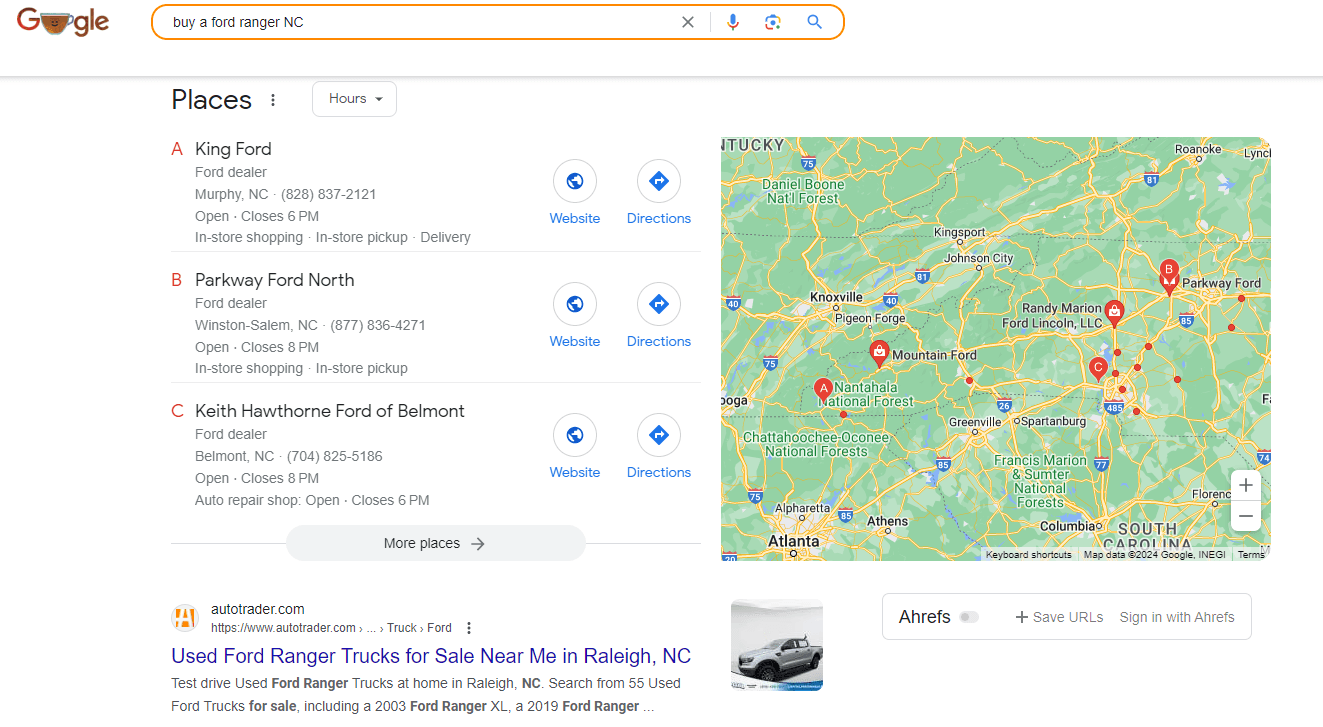
How to Get Started with an Automotive PPC Campaign
Now that you have an idea of the different types of general automotive PPC campaigns, the next section explains how to set up your first campaign step by step with Google Ads.
We’ve chosen Google Ads because it’s the PPC advertising platform of the world’s most popular search engine, responsible for 92% of all searches.
➡️ Define your goals
Before you start building your PPC campaign, you need to set a goal that determines what you want to achieve with the ad campaign.
Here are some examples of common paid advertising goals for auto dealerships and other automotive businesses:
📈Increasing website traffic: This is often the most immediate goal of a PPC campaign. For an automotive business, this could mean attracting potential customers to view new models, promotions, or informational content.
📈Generating leads: This involves not just attracting visitors but converting them into leads. This could lead to visitors signing up for test drives, requesting more information, or subscribing to newsletters. Define what a 'lead' means for your business—is it an email sign-up, a phone inquiry, or something else?
📈Boosting sales: Ultimately, the primary goal may be to increase sales. This could involve tracking how many PPC-led visitors make a purchase, book a service appointment, or place a deposit on a vehicle.
📈Brand awareness: Apart from attracting direct sales or leads, your PPC campaign can also aim to enhance brand awareness and reputation. This is particularly important for new automotive brands or those repositioning in the market.
🧠 Expert insight: Be specific
“Start by being specific about what you want to achieve. For instance, rather than just aiming to increase website traffic, define how much of an increase you want.
For example, set a target of a 30% increase in website visitors over the next quarter. This level of specificity makes your goals more tangible.”
Align your goals with your business objectives
Ensure that your PPC campaign goals align with your broader business objectives. If your dealership is looking to clear out last year's models, your PPC campaign should focus on promoting those vehicles specifically.
Measuring success
Define how you will measure the achievement of these goals. Will you use metrics like click-through rates, conversion rates, or the number of leads generated? Tools like Google Analytics can help track these metrics.
➡️ Optimize your landing pages
Most (but not all) PPC campaigns link to a dedicated landing page on the company’s website.
Landing pages are optimized to:
🔸 Meet the specific needs of automotive buyers: Your ad campaign should link to a landing page that meets potential customers' needs. It should provide clear information about car models, their features, prices, and financing options. The closer the page matches what the customer originally searched for or clicked on, the more likely it is to lead to sales.
🔸 Build trust: Trust is key in the automotive industry. Your landing page should build credibility fast by displaying certifications, awards, customer reviews, and clear contact details for your dealership or service.
🔸 Convert visitors: Your landing page should aim to convert visitors into leads or customers with a clear call to action (CTA). This could include scheduling a test drive or requesting a quote. Ensure that taking these actions is straightforward and user-friendly.
🔸 Easy contact options: Provide multiple ways for visitors to contact your dealership or automotive service. These could include a phone number, an online chat feature, a contact form, or an option to book an appointment online.
🔸 Maximize brand exposure: Use consistent logos, colors, and messaging on your landing page to reflect your automotive company's brand identity. A well-branded page helps make your company memorable, even if visitors don't immediately convert.
🧠 Expert insight: Preparation is Key
In our experience, it’s important to ensure that your landing page is fully optimized before setting up a PPC campaign. This includes testing loading times, mobile responsiveness, and the clarity of your messaging.
The page should be ready to handle the traffic generated from your PPC ads effectively.
For example, let’s say we search for “car dealership raleigh nc”. Here’s what comes up:
Let’s take a look at the first result, HendrickCars:
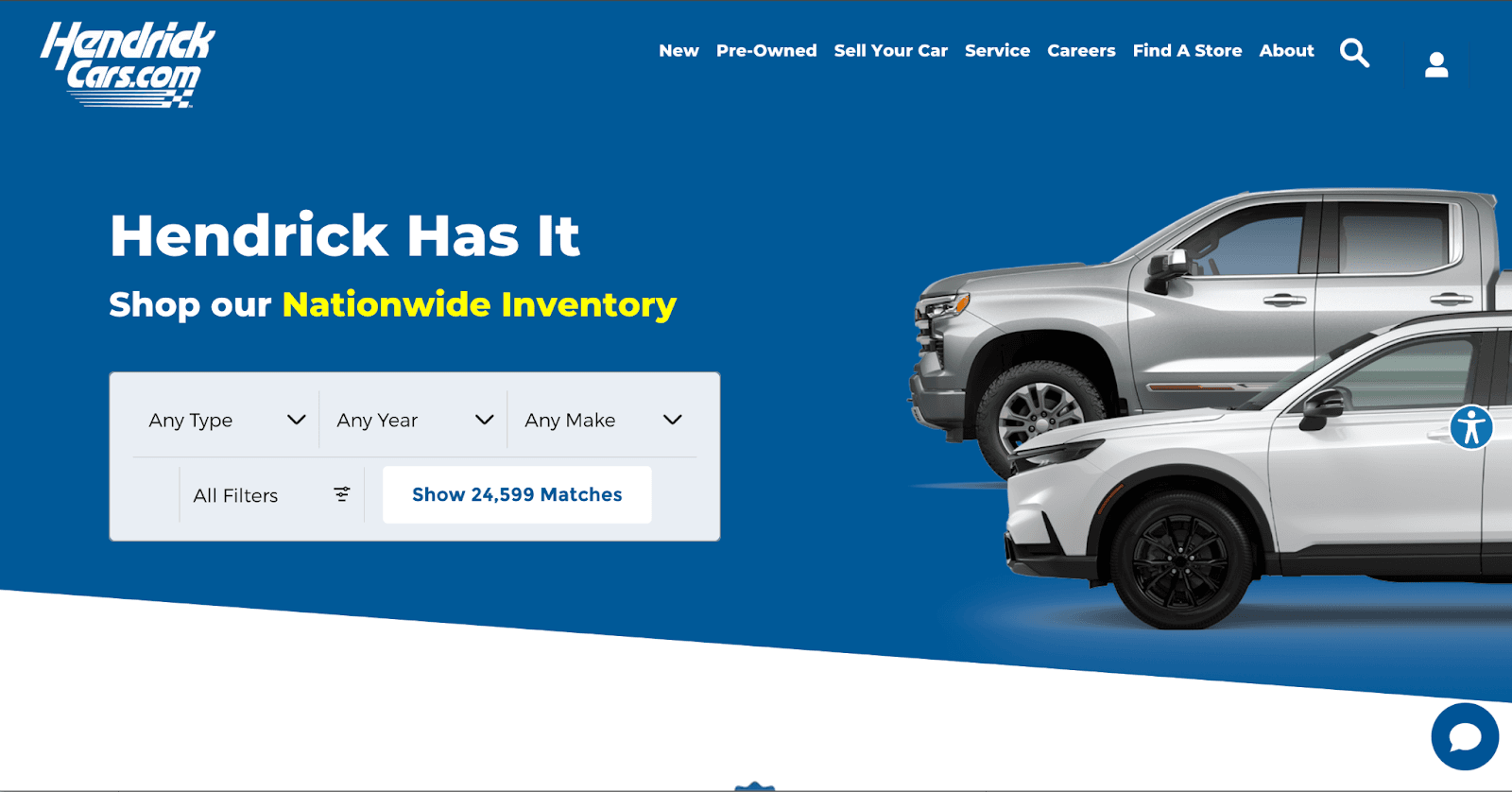
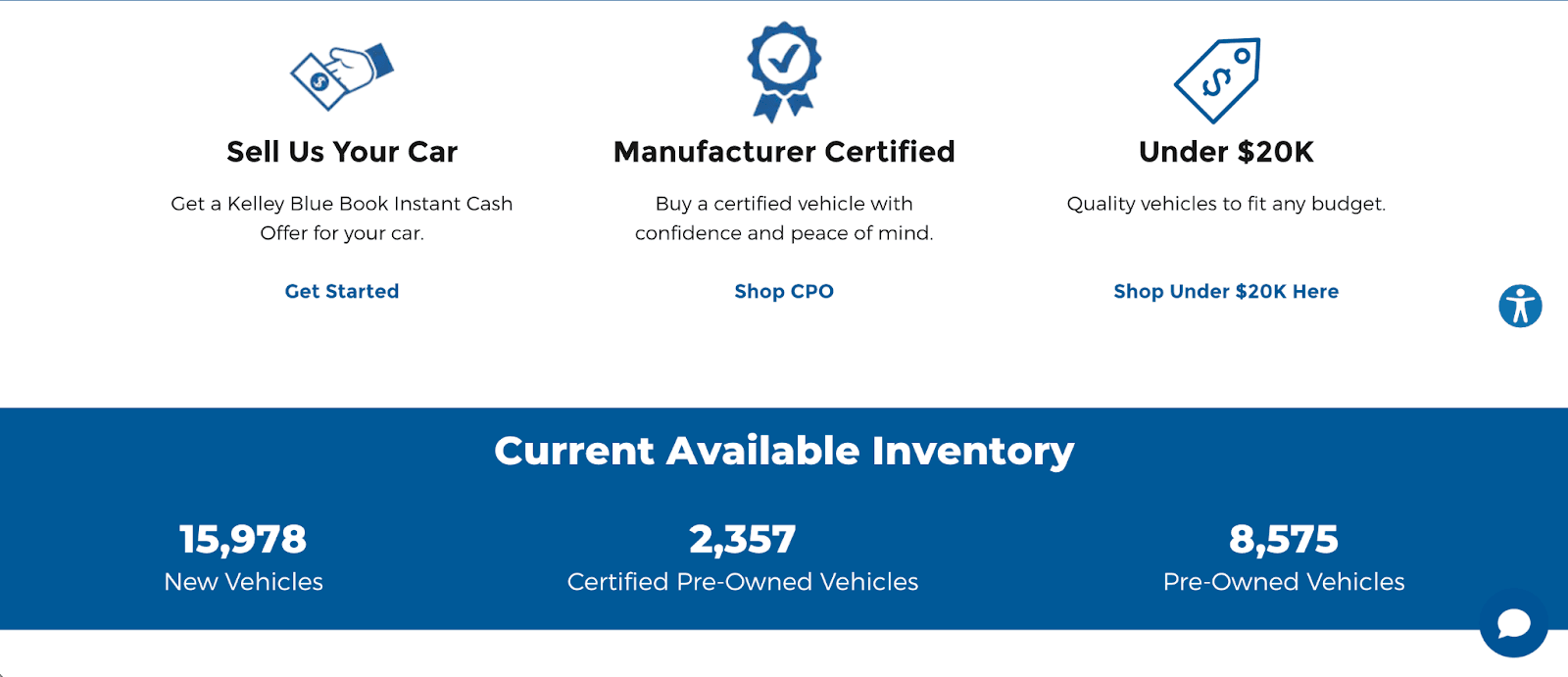
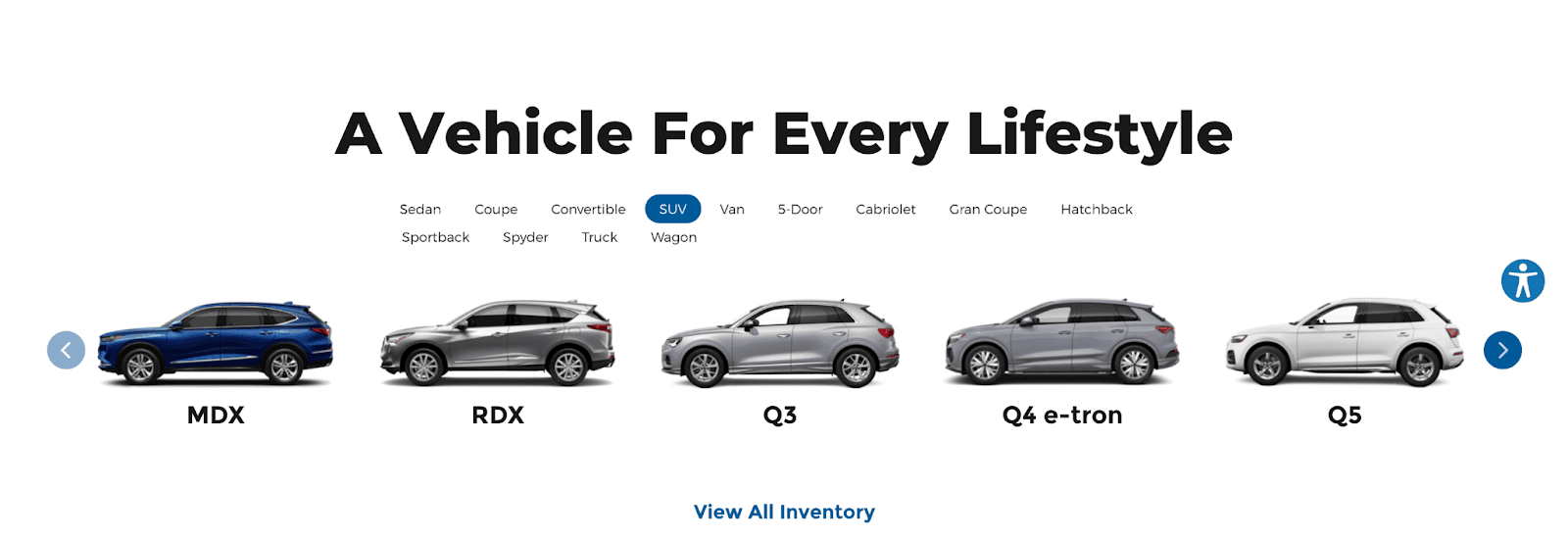

Here’s why this page works:
✔️Clear CTA: Visitors can start looking for a car straight away.
✔️Easy to make contact: The page provides a customer chatbot to easily handle inquiries.
✔️Nice design: The page looks smart and is easy to use.
✔️Strong branding: The Hendrick Cars logo and brand colors are simple and easy to recognize.
✔️Social proof builds trust: At the bottom of the page, Hendrick Cars has a section on the “Hendrick Difference” that features reviews and awards to show visitors that they are a trusted car re-seller.
➡️ Create your Google Ads account
If this is your first automotive PPC campaign, you will need to set up your Google Ads account to get started. The good news is it’s completely free.
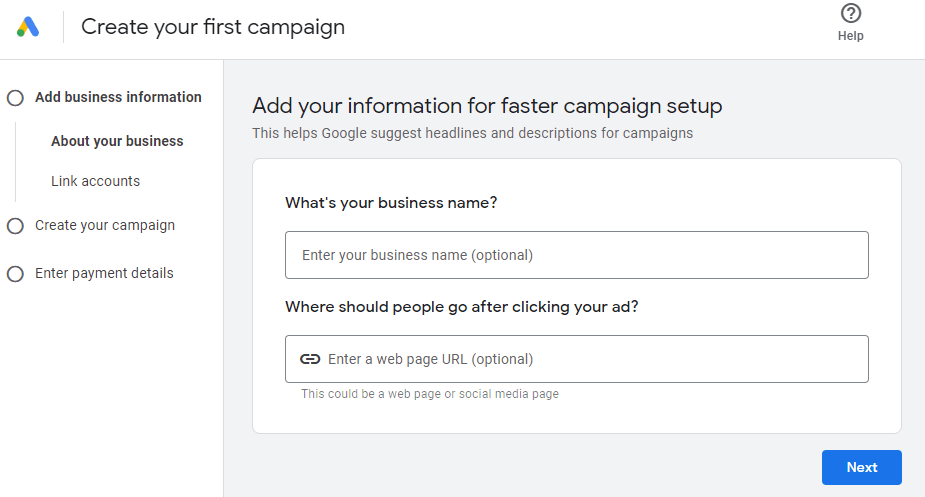
Creating your account is quite simple and only requires a few steps, and then you can get your campaign up and running.
You’ll need to provide:
✅ Information about your business
✅ Details about your campaign goals and budget
✅ Your credit card details
➡️ Set up your target audience
To ensure your automotive PPC campaign is effective, Google Ads gives you the option to target specific users.
You could target demographics like:
- Location
- Age group
- Gender
- Household income
- Interests
- Search behavior
Let’s say your business sells Toyota car parts in San Diego.
Your PPC campaign could target San Diego residents aged 20-50, a demographic that encompasses a broad range of Toyota owners who are likely to require parts for maintenance or upgrades.
You can also further refine your audience to those with interests in Toyota models, automotive DIY, or vehicle maintenance.
This would ensure your ads reach the most relevant people in your local area.
Target local customers with geotargeting
Geotargeting in Google Ads is a feature that allows advertisers to specify the geographic locations where they want their ads to be shown.
This feature is a critical tool for automotive businesses because a lot of your customers will be local (unless, of course, you are selling primarily online).
By targeting specific geographic areas, you can ensure that your ads reach those potential customers nearby who are most likely to visit your dealership or auto service center.
Here’s an example of a good local ad:
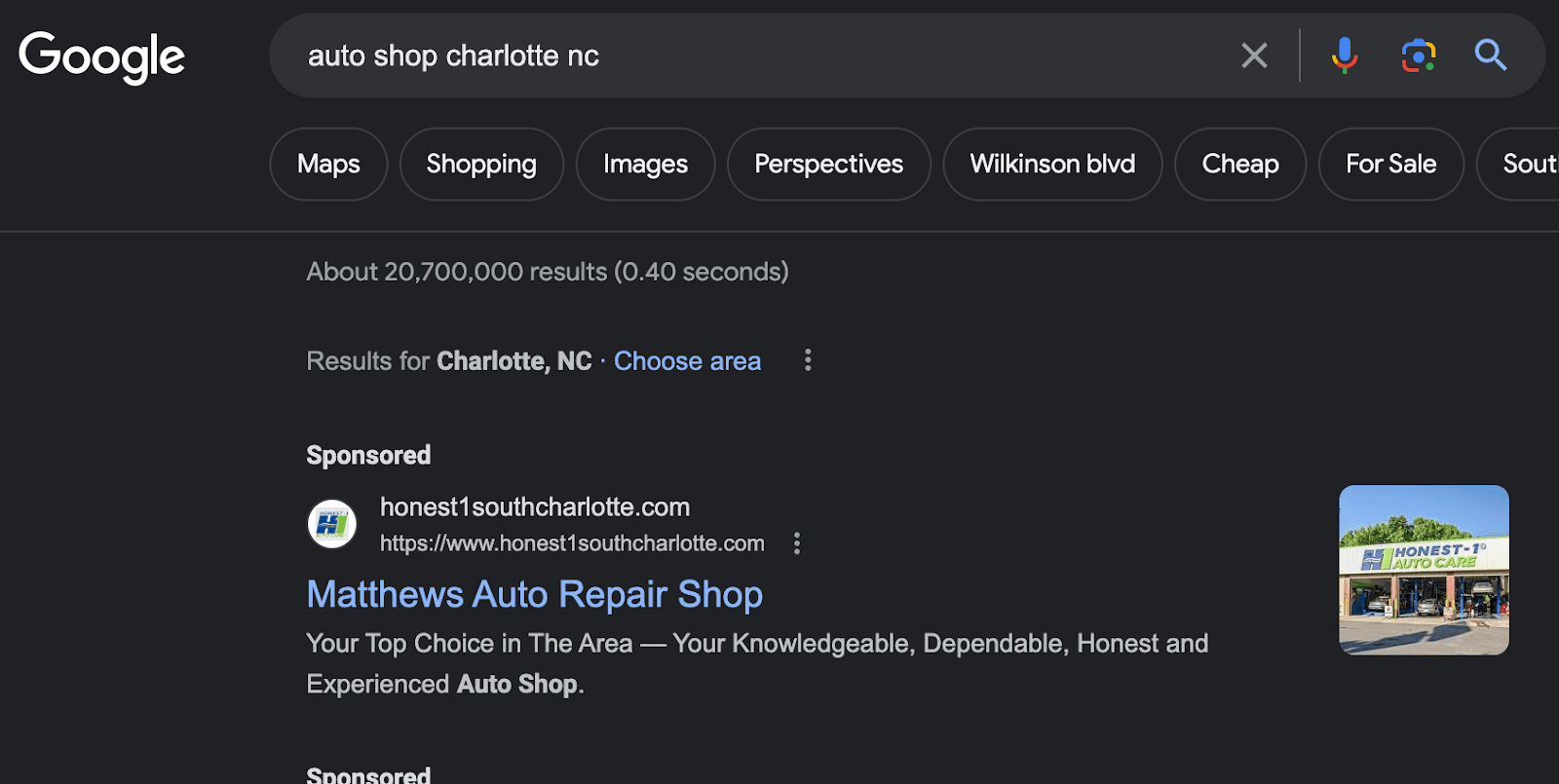
➡️ Select your keywords
After you have selected your target audience, the next step is to do some research on the keywords and phrases they may type into a Google search bar.
To get this step right, you’ll need a tool like Google Keyword Planner, Ahrefs, or SEMRush.

You need to find keywords that:
✅ Are relevant to what you do.
✅ Show strong buyer intent.
✅ Are affordable: Cost-per-click (CPC) measures the estimated amount you’ll pay per click for this term.
✅ Get lots of searches: This is usually called volume or traffic.
✅ Aren’t too competitive: As the name suggests, keyword difficulty indicates how difficult it is to rank for a keyword organically. Google Ads refers to this as keyword competitiveness.
In PPC advertising, keywords that have a higher keyword difficulty tend to be more expensive because they are more competitive.
💬 Narrow down your list of keywords
Once you’ve figured out the types of content your target audience is likely searching for, you can narrow this list down to specific keywords you want to focus on.
To borrow the same example, you might specialize in selling Toyota parts.
You could start with a broad range of keywords like:
🔍Toyota auto parts
🔍Toyota parts online
🔍Buy Toyota parts
🔍Replacement parts for Toyota
🔍Toyota OEM parts
🔍Toyota aftermarket parts
🔍Toyota parts near me
If you, however, have a strong online presence, you might realize that certain keywords are more relevant to your business and you might want to focus more on:
🔍 Toyota parts online
🔍 Buy Toyota parts
This way, you target your efforts on the keywords that are most likely to help your business grow.
💬 Use negative keywords
When managing your PPC campaigns, it's also important to identify and use negative keywords.
These are terms that, when searched for, will prevent your ad from being displayed, helping to avoid irrelevant traffic.
If you specialize in selling parts for Toyota cars, you might want to exclude searches that are not related to your inventory or service focus.
For example, you may decide to use negative keywords like:
👎Free Toyota parts
👎Used Toyota cars
👎Toyota car rentals
👎Toyota repair manuals
This strategy helps save your ad budget for more qualified leads and focuses on customers who actively search for your products.
➡️ Utilize ad extensions and add a “Call Us” feature
A call extension is a feature in Google Ads that lets advertisers put their phone numbers in their ads.
When people see the ad, they can click on this phone number to quickly call the business.
In the automotive industry, this ad extension is crucial. Research has shown that 61% of new and used vehicle shoppers call the dealership after a search.
To set up a call extension in Google Ads, follow these steps:
- Go to the Google Ads website and log in to your account.
- Choose the campaign or ad group to which you want to add the call extension.
- Find the "Ads & Extensions" tab from the left page menu.
- Click on the "Extensions" tab at the top.
- Click on the plus button ("+") and select "Call Extension" from the dropdown menu.
- Input the phone number you want to use for the call extension.
- Once you've entered all the necessary information, click "Save" to apply the call extension to your selected campaign or ad group.
➡️ Write compelling ad copy
Creating effective ad copy for PPC ads is crucial for automotive businesses. Your ads need to grab a potential customer’s attention and encourage them to visit your website.
Here's how to craft ad copy that stands out:
✔️ Know your audience: Understand your target market's needs and level of automotive knowledge. Use language that resonates with them, whether they're enthusiasts or everyday drivers.
✔️ Keep it concise: Use a brief yet impactful headline and description. Highlight what makes your service or product unique, such as special deals or top-notch service.
✔️Strong call to action (CTA): Use action-oriented phrases like "Book a Test Drive," "Get a Free Quote," or "Call Us" to attract clicks.
✔️Avoid jargon: Minimize technical terms to make your ad accessible to a wider audience.
✔️Focus on benefits: Emphasize how your product or service solves a problem or enhances the customer's life. Mention special offers, warranties, or exclusive features that set you apart.
Below is an example of well-written ad copy:

➡️ Place a bid
Next, you’ll need to place a bid in a PPC auction to get your ad to appear at the top of search engine results. You’ll want to set up your bidding based on your specific keywords.
This is also where you get to stipulate how much you are willing to spend on your ads.
➡️ Start tracking your PPC campaign
One of the major benefits of using Google Ads for your PPC campaigns is the ability to closely track and measure their performance, which is crucial for understanding their effectiveness.
Key metrics to track
- Click-through rate (CTR): Measures how often people click your ad after it's shown.
- Conversion rate: Tracks how many clicks on your ad result in a desired action, like a purchase or sign-up.
- Cost per click (CPC): This shows the average cost you pay for each click on your ads.
- Impressions: Impressions are the number of times your ad is shown. Impression share is the percentage of times your ad is shown out of the total available impressions for your target audience.
Monitor and analyze performance
Regularly check these metrics in Google Analytics and Google Ads to gauge how your campaign is performing.
Look for trends, such as which ads are performing well and which times of day yield the best results.
Adjust based on insights
Use the data you gather to make informed adjustments to your campaign. This might include changing your ad copy, adjusting your bid strategy, or refining your target audience.
Continuous monitoring and tweaking based on performance data is key to improving the effectiveness of your PPC campaigns.
To help illustrate what we mean here, we’ve created an example:
An automotive dealership, "City Motors," launches a PPC campaign in Google Ads to promote their latest range of electric vehicles.
Below are the key metrics they are tracking:
Click-through rate (CTR): In Google Analytics, they monitor the CTR to see how well their ad captures interest. For instance, they notice a CTR of 3%, which is above the industry average, indicating strong ad relevance.
Conversion rate: The campaign's main goal is to get users to sign up for test drives. They track how many of these clicks result in sign-up forms being filled out.
Cost per click (CPC): They keep an eye on the CPC to manage their budget efficiently.
Impressions and impression share: They monitor these to understand how often their ads are being shown compared to the total available market.
📈 Analysis and adjustments
Mid-campaign review: After two weeks, they notice that the ads shown in the evenings have a higher CTR and conversion rate.
However, the morning slots have lower performance metrics.
📈 Campaign adjustments
✅ Bid adjustments: City Motors increases their bid for the evening time slots while reducing it for mornings, thereby allocating more budget to the high-performing time.
✅ Ad copy refinement: They also notice that ads featuring specific electric vehicle models perform better. They tweak their lower-performing ads to highlight these popular models.
✅ Landing page optimization: The conversion rate is lower than expected. They optimize the landing page for faster loading and add a clear call to action, leading to an improved user experience.
📈Results
After having made these adjustments, City Motors sees an increase in both their CTR and conversion rates.
The targeted evening ads lead to more test drive sign-ups, and the optimized landing page results in a better conversion rate.
This example illustrates how an automotive business can effectively use Google Ads and Google Analytics to track, analyze, and refine their PPC campaigns for better performance and return on investment.
➡️ Retarget
Retargeting is a key strategy for automotive businesses using Google Ads.
It's all about reconnecting with people who visited your site but didn't make a purchase or contact you at the time.
Here’s a simplified look at how it works:
- Visit and leave: A potential customer checks out your website but leaves without buying anything or getting in touch.
- Cookie tracking: A cookie (a small tracking code) is placed in their browser while they’re on your site. This tracks their web browsing anonymously.
- Ads follow them: When they surf the web, your ads pop up on other sites within the Google Display Network. These can be banner ads reminding them of your cars or services.
- Bring them back: The aim is to catch their attention again and bring them back to your site, hopefully to make a purchase or contact your dealership.
Here is an example from a website where a display ad is being shown to a user who has previously visited a car dealership’s website:
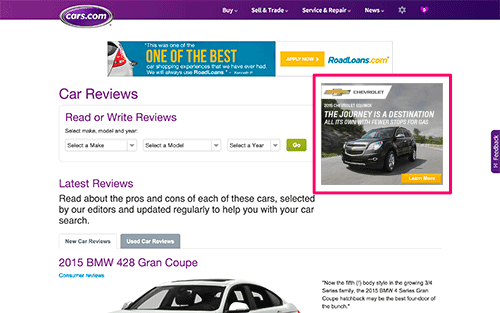
For automotive businesses, retargeting is an effective strategy to keep your brand in the minds of interested customers.
It gently reminds them of your products and services, encouraging them to make a purchase or book a service.
Advanced Tactics for Automotive PPC
Leveraging In-Market Audiences
In-market audiences within Google Ads offer a powerful way to target users actively researching car purchases, specific car models, or related services like maintenance.
This goes beyond basic demographic targeting and allows you to be laser-focused, significantly increasing the relevance and effectiveness of your campaigns.
Here's how to leverage In-Market Audiences:
Within the Google Ads platform, navigate to the "Audiences" section. Here, you can create new audience segments. Choose "Browse" and select "In-market audiences" from the menu.
Targeting options:
➡️Broad categories: Start with categories like "Autos & Vehicles" or "New Car Buyers." This captures a wide audience actively researching car purchases.
➡️Refine targeting: Refine your audience by selecting subcategories within the chosen category. For example, under "Autos & Vehicles," you can target users interested in "Buying Specific Brands" and choose specific brands like "Ford" or "Toyota."
➡️Layer with additional segments: Don't stop there! Combine In-Market Audiences with other targeting options like demographics (age, income, location), interests, and custom intent audiences based on specific search queries. This allows for highly targeted campaigns reaching users at various stages of the car-buying journey.
Link Google My Business with Google Ads
Linking your Google My Business listing with your Google Ads campaigns allows you to showcase your dealership address and phone number directly within your ads, making it easier for potential customers to find your location and contact you.
Benefits of Utilizing Google My Business:
✅ Increased local visibility: Improve your dealership's ranking in local search results, leading to more organic discovery by potential customers searching for car dealerships nearby.
✅ Enhanced brand trust: Positive reviews, accurate information, and engaging posts build trust and credibility with potential customers.
✅ Improved customer engagement: GMB features like posts and messaging offer direct communication channels with potential customers, fostering engagement and driving conversions.
Level up location targeting
Location targeting within Google Ads is crucial in ensuring your automotive dealership's PPC campaigns reach the right audience at the right time.
You can target by:
🎯Dealership location
Target specific geographic areas surrounding your dealership locations. This ensures your ads are shown to users searching for car dealerships or related services in your immediate vicinity.
Also, don’t forget to exclude areas irrelevant to your target audience, like airports or rural areas with no potential customers.
🎯Competitor locations
Go beyond your physical location and consider targeting areas where your competitors are. This can be particularly effective if you offer unique selling points (USPs) or competitive advantages over your rivals.
🎯Search volume
Utilize tools like Google Trends or keyword research tools to identify areas with high search volume for your target car models or related services. This allows you to focus your ad spend on locations with a higher potential customer base actively researching car purchases.
💡Pro-tip: Combine location targeting strategies with other options like demographics, interests, and income levels to create highly targeted campaigns reaching the most relevant audience.
How PPC.io Can Elevate Your Automotive PPC Efforts
We know automotive PPC can seem complicated, and making mistakes can be costly. That's where we come in. We're experts in PPC and can help you avoid these pitfalls.
At PPC.io, we’ve assisted many businesses in building an automotive PPC strategy that really works. We focus on what matters: smart strategy, the right keywords, clear ad copy, and smart bidding.
Want to see your automotive business get ahead? Reach out to PPC.io. Visit our website to get in touch
